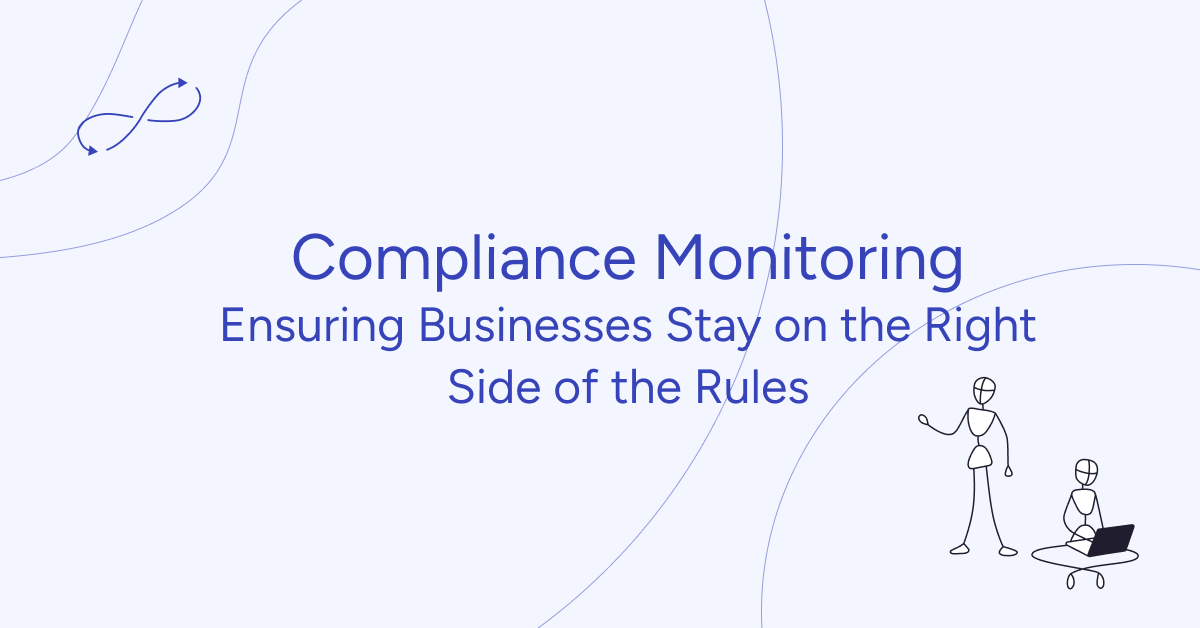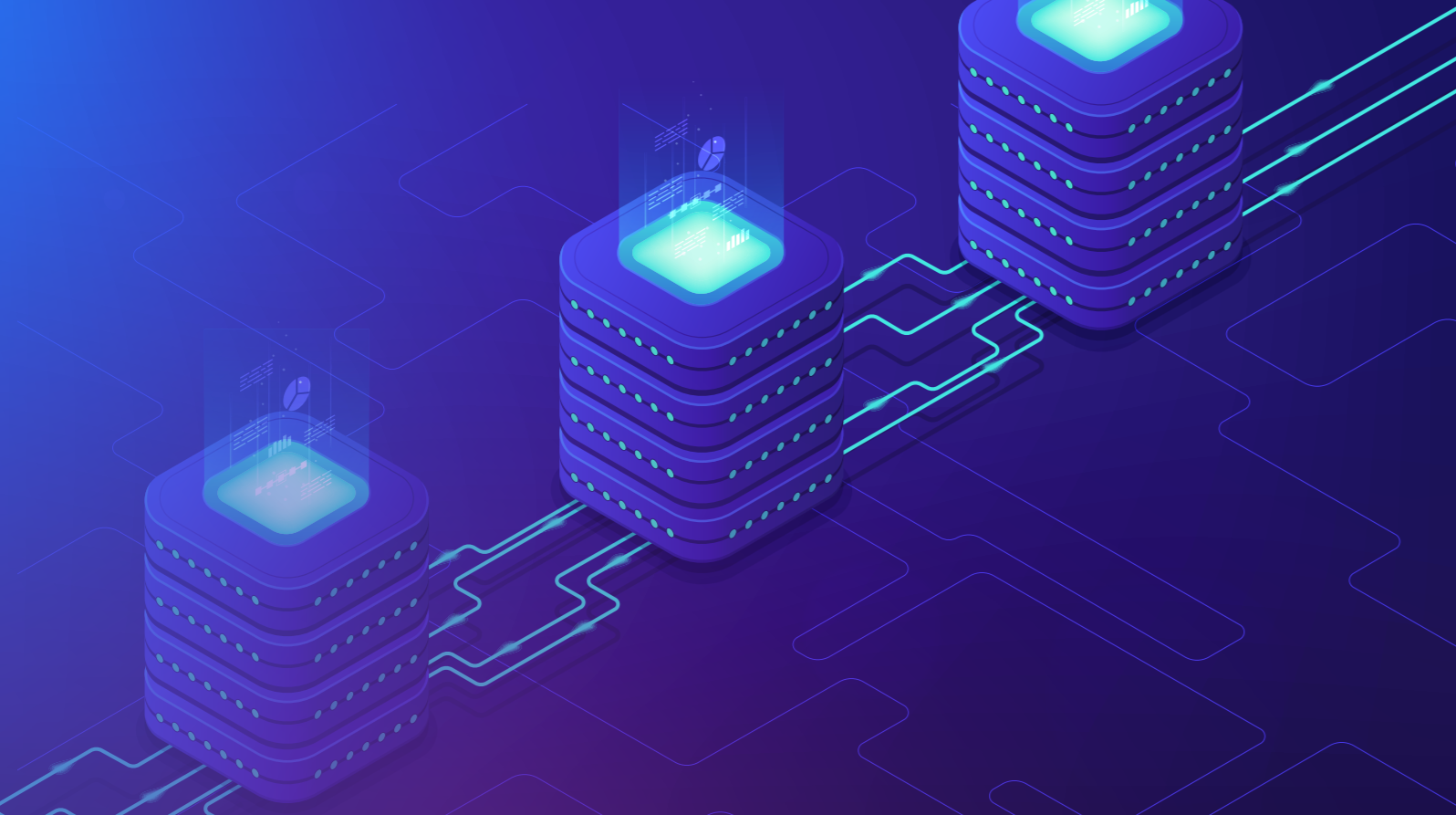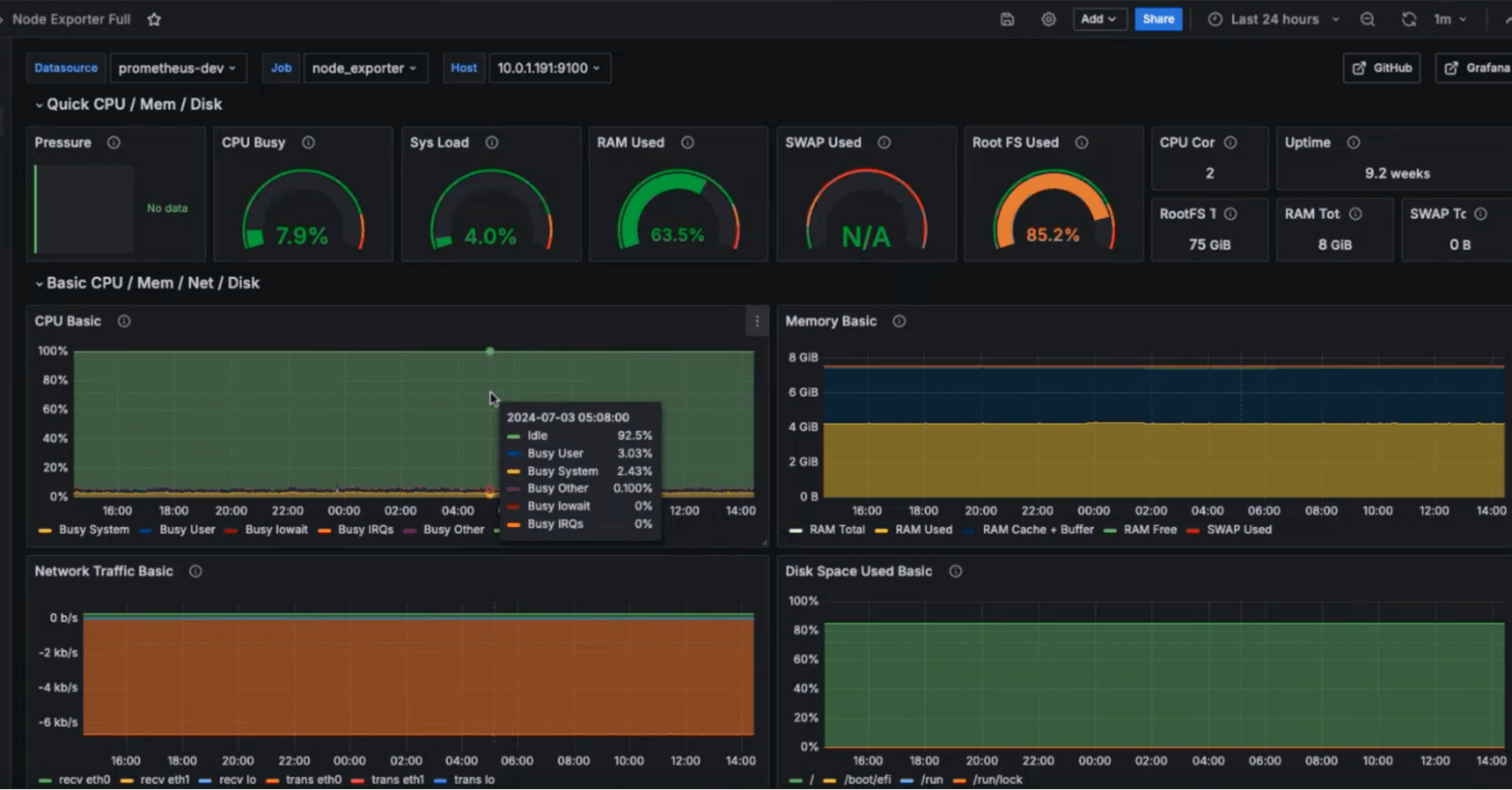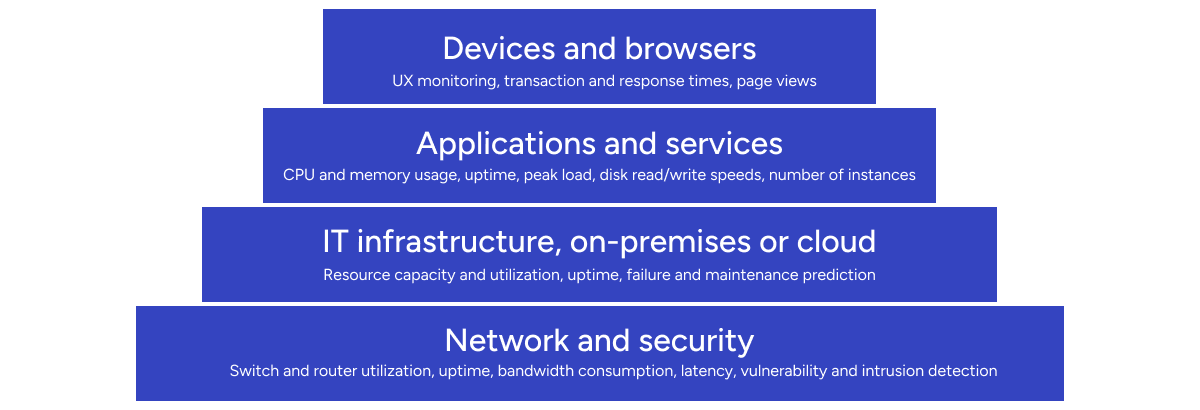
What is Infrastructure Monitoring in DevOps?
Imagine driving a car with no dashboard. You wouldn’t know your speed, fuel level, or engine temperature – until you break down. That’s exactly what monitoring is for DevOps. It’s the dashboard that keeps your digital solutions running smoothly. In simple terms, monitoring in DevOps means continuously collecting, analyzing, and interpreting data about your systems, applications, and infrastructure to ensure everything works as it should.
Monitoring covers the entire ecosystem – cloud resources, servers, containers, applications, databases, and networks. It tells you what’s happening under the hood, provides insights to optimize performance, and alerts you when something goes wrong.
For example, in a modern microservices architecture, dozens of interconnected services communicate simultaneously. If one service fails or becomes slow, the entire application performance is affected. Infrastructure Monitoring acts as your real-time detective, pinpointing the exact root cause quickly so your team can resolve it before users even notice.
But monitoring is not just about “checking if it’s working.”
It empowers:
Proactive issue resolution before impacting users.
Data-driven decision making for capacity planning.
Enhanced security through anomaly detection.
Better customer experiences by ensuring fast and reliable services.
In DevOps, where continuous integration and deployment (CI/CD) pipelines push updates rapidly, monitoring becomes a safety net to catch failures early, enabling fast recovery without fear of hidden issues.
Why Monitoring is Crucial?
Without monitoring, DevOps is like flying blind. Here’s why it’s crucial:
Faster Troubleshooting & Reduced DowntimeImagine an e-commerce app going down during a flash sale. Every minute lost equals revenue lost. Monitoring provides real-time visibility, helping teams resolve incidents instantly.
Performance OptimizationMonitoring uncovers bottlenecks in CPU, memory, databases, or network, enabling teams to fine-tune configurations for peak performance.
Informed Capacity PlanningBy understanding usage trends and traffic patterns, businesses can plan future infrastructure needs, avoiding costly over-provisioning or risky under-provisioning.
Compliance & SecurityRegulatory standards often require detailed system logs and audit trails. Monitoring ensures all activities are recorded and security threats are detected early.
Better User ExperienceModern users expect instant, smooth interactions. Monitoring ensures your app’s uptime, speed, and reliability remain consistent, building user trust and brand reputation.
Ultimately, monitoring forms the backbone of a reliable, scalable, and resilient DevOps ecosystem.
The Complexity of Monitoring in DevOps
Why is Monitoring Complex?
Monitoring might sound straightforward – just install tools, collect metrics, and view dashboards, right? Not exactly. The complexity arises because:
There’s no universal approachEvery project, application, and infrastructure has unique requirements.
Data overload is realWith thousands of metrics streaming in, identifying what truly matters is challenging.
Interdependencies complicate monitoringIn microservices, one service’s failure can ripple into many others, making root cause analysis tough.
Rapidly changing environments in CI/CD mean that monitoring configurations need continuous updates.
For example, monitoring a static on-prem server cluster differs entirely from monitoring dynamic Kubernetes pods that scale up and down rapidly based on traffic.
Key Challenges Faced
Here are the major challenges that make monitoring a complex task:
Identifying Critical MetricsNot everything needs to be monitored. Picking metrics that impact business goals without drowning in unnecessary data is an art.
Tool OverloadUsing multiple tools for logs, metrics, and traces often leads to fragmented insights, increasing mean time to detect (MTTD) and resolve (MTTR) incidents.
Alert FatiguePoorly configured alerts trigger for trivial issues, causing teams to ignore even critical alerts over time.
Integration with DevOps PipelinesMonitoring must integrate seamlessly with CI/CD pipelines to maintain visibility across automated deployments.
ScalabilityAs systems grow, monitoring solutions must handle massive data volumes without becoming performance bottlenecks themselves.
Cost ManagementHigh-frequency data collection and storage in third-party monitoring platforms can escalate costs significantly if not optimized.
Effective monitoring strategies address these complexities through smart metric selection, streamlined tools integration, and automation.
Determining what to monitor, what truly matters for the project, requires DevOps engineers to:
Identify what to monitor,
Determine what to display,
Define how to execute these tasks.
The most critical question is not how to monitor, but what to monitor.
Types of Monitoring in DevOps
Monitoring spans multiple layers of your tech stack. Understanding these layers helps design a holistic monitoring strategy.
Cloud Level MonitoringMonitors services offered by cloud providers like AWS, Azure, and Google Cloud, including resource health, billing, and policy compliance.
Infrastructure Level MonitoringCovers physical and virtual servers, databases, networks, and storage systems to ensure foundational stability.
Abstraction Level MonitoringFocuses on containers (Docker), orchestration (Kubernetes), and virtual machines to manage application deployment environments efficiently.
Application Level MonitoringTracks application performance, transactions, errors, and user experiences to maintain high service quality.
Each layer has distinct metrics, challenges, and tools. Ignoring any of these layers can leave blind spots in your monitoring setup, risking operational inefficiencies.
In essence, monitoring involves tracking the state of a solution across these levels to ensure optimal performance, efficiency, and reliability.
Cloud Level Monitoring Explained
Cloud environments form the base of most modern digital solutions. Here’s what cloud monitoring involves:
AWS Monitoring
AWS offers CloudWatch, a powerful tool to collect logs, metrics, and events. For example:
EC2 instances: CPU utilization, disk I/O, network throughput.
RDS databases: Connection counts, read/write latency.
Lambda functions: Invocation errors, duration, throttles.
AWS CloudWatch integrates with SNS for alerts and with third-party tools like Grafana for enhanced visualizations.
Azure Monitoring
Azure’s native monitoring solution is Azure Monitor, which provides:
Metrics collection across resources.
Log Analytics for querying data.
Application Insights for real-time application performance monitoring.
Azure Monitor’s integration with Sentinel further enhances security monitoring, creating a unified observability and threat detection system.
Google Cloud Monitoring
Google Cloud offers Operations Suite (formerly Stackdriver), which includes:
Monitoring: Dashboards, alerts, uptime checks.
Logging: Centralized logs collection across resources.
Error Reporting & Debugging: Application error tracking with detailed stack traces.
It integrates seamlessly with Google Kubernetes Engine (GKE) for container monitoring.
Cloud level monitoring ensures visibility, compliance, and optimal resource utilization, preventing unexpected bills and downtimes.
Infrastructure Level Monitoring
Infrastructure is where your applications run. Infrastructure monitoring tracks the performance, availability, and health of physical and virtual infrastructure components, including servers, networks, databases, and storage systems.
Server Monitoring
Servers, whether physical or virtual, need constant health checks:
CPU load: Spikes can slow down applications.
Memory usage: Memory leaks can crash services.
Disk usage: Full disks prevent applications from writing data.
Process monitoring: Detects failed processes and restarts them automatically.
Tools like Nagios, Zabbix, and Prometheus Node Exporter help collect these metrics effectively.
Abstraction Level Monitoring Detailed
Container Monitoring (Docker)
Containers have revolutionized software deployment. But their dynamic nature demands specialized monitoring.
What is Container Monitoring?Container monitoring tracks resource utilization and performance of containerized applications. For Docker, it involves:
CPU and memory usage per container
Container uptime and health checks
Network I/O for container communications
Storage usage within containers
Why is it Important?Unlike traditional VMs, containers share the host OS kernel, meaning resource contention can arise quickly, affecting multiple services. For example, if one container uses excessive CPU, others on the same host may suffer degraded performance.
Tools for Docker Monitoring:
cAdvisor (Container Advisor): Developed by Google, it provides container-level resource usage and performance characteristics.
Prometheus with cAdvisor exporter: Stores and queries container metrics efficiently.
Grafana dashboards: Visualize container health and performance trends for quick analysis.
Monitoring Docker ensures containers run optimally without affecting other workloads, which is essential in microservices architectures.
Orchestration Monitoring (Kubernetes)
Kubernetes (K8s) automates container orchestration, but its complexity demands deep observability.
What does Kubernetes Monitoring Involve?
Cluster health status
Node and pod resource usage
Deployment statuses and scaling behaviors
Networking, service discovery, and ingress traffic
Events and error logs within the cluster
Key Tools:
Prometheus + kube-state-metrics: Collects metrics about cluster states, pods, nodes, and deployments.
Grafana dashboards: Visualizes Prometheus metrics into user-friendly dashboards for DevOps teams.
Kubernetes Dashboard: A web UI to manage and monitor clusters but limited in observability compared to Prometheus-Grafana stacks.
Kubernetes monitoring ensures application scalability, reliability, and quick issue detection across dynamically scaling pods.
Virtual Machine Monitoring
Virtual machines (VMs) are still widely used alongside containers.
What should you monitor in VMs?
CPU, memory, and disk I/O usage
Network latency and throughput
Hypervisor resource allocation
VM uptime and performance anomalies
Tools for VM Monitoring:
Nagios & Zabbix: Traditional yet robust monitoring solutions for VM environments.
Prometheus node exporters: Collect metrics from VMs for visualization in Grafana.
Monitoring VMs ensures stability, efficient resource allocation, and smooth performance for hosted applications.
Application Level Monitoring
Focuses on tracking the performance, availability, and user interactions of applications, providing insights into response times, error rates, and transaction flows. APM focuses on how well your application runs from the end-user perspective.
Application Performance Monitoring (APM)
Transaction Tracing
User Experience Monitoring
What does APM track?
Response times of APIs and services
Application error rates
Backend database query performance
Third-party service integrations
Popular APM Tools:
New Relic: Provides deep application insights with transaction traces.
Datadog APM: Offers distributed tracing and performance analytics.
Dynatrace: Uses AI-powered automation to monitor and optimize application performance.
APM helps ensure users experience fast, reliable, and error-free applications, directly impacting business revenue and user satisfaction.
Get a sample of IT Audit
Sign up now
Get on email
Loading...
Thank you!
You have successfully joined our subscriber list.
Three Pillars of Monitoring
Logs - Logs record events with timestamps, creating a chronology of processes occurring within the system.
Metrics - Metrics demonstrate resource usage levels or behaviors that can be collected in systems.
Traces - Traces illustrate the journey of a user through the entire application stack.
Why are logs important?
They capture detailed insights for troubleshooting. For instance, if an API fails, logs show the error type, timestamp, and potentially the root cause.
Best Practices:
Use structured logging for easier querying.
Avoid logging sensitive data to remain compliant.
Centralize logs using tools like ELK Stack (Elasticsearch, Logstash, Kibana) or Grafana Loki for faster access.
Metrics
Metrics are numerical data points representing system behaviors or statuses over time.
Examples:
CPU utilization %
Number of active users
API request latency
Database query counts
Metrics are ideal for trend analysis and alert configurations to trigger immediate actions when thresholds are breached.
Traces
Traces track the flow of requests across different services and components.
For example, an e-commerce checkout trace might involve:
Frontend click event.
Backend order service.
Payment gateway integration.
Inventory database update.
Confirmation email service.
Tracing tools like Jaeger and Zipkin visualize this journey, making debugging distributed systems efficient.
Monitoring Tools - Choosing the Right Monitoring Stack
Grafana and Prometheus are among the most widely used, free, and open-source solutions. These tools together create a solid foundation for a robust and reliable monitoring stack, ensuring high-quality analysis.
Grafana: This powerful visualization tool displays data from various sources in customizable dashboards, making it easier to understand and act on complex metrics.
Prometheus: A leading open-source monitoring and alerting toolkit, known for its reliability and scalability in gathering and querying metrics.
Grafana Loki: A log aggregation system that integrates smoothly with Grafana, allowing for comprehensive log management and analysis.
Other notable tools in the monitoring ecosystem include:
Datadog: A comprehensive monitoring and analytics platform that provides visibility into your entire tech stack, from infrastructure to applications.
New Relic: An observability platform that offers detailed insights into application performance, helping to quickly identify and resolve issues.
Cost vs Features Analysis of Monitoring Tools
Let’s simplify a comparison in a table for clarity:
ToolBest ForCost ModelKey FeaturesPrometheusMetrics monitoringFree, self-hostedTime-series metrics collection, alert managerGrafanaVisualizationFree, self-hosted or SaaSCustomizable dashboards, plugins, alertingGrafana LokiLog aggregationFree, self-hosted or SaaSIntegrates with Grafana, efficient log storageDatadogFull-stack observabilityPer host / per GB ingestedAPM, infrastructure, logs, security monitoringNew RelicApplication performancePer user / usage-basedDistributed tracing, synthetics, browser monitoring
Selecting your stack wisely ensures cost optimization without compromising observability.
By leveraging these tools and practices, you can create a monitoring setup that provides actionable insights, helping you to quickly respond to issues, optimize performance, and ensure the overall health of your digital solutions.
Real-World Monitoring Use Cases
1. Music SaaS Platform Case Study
Challenge:A B2C SaaS music platform needed real-time visibility across its globally distributed infrastructure to support millions of concurrent users.
Solution:By integrating AWS CloudWatch and Grafana, the team built dashboards displaying:
Regional server performance metrics
Database query performance
API error rates
User streaming latency per region
Impact:
Enabled seamless scalability during peak loads (e.g., global music release days)
Reduced operational interruptions with proactive alerts
Improved user experience through optimized backend performance
This approach empowered the platform to grow globally while maintaining cost efficiency and high availability.
2. Digital Landfill Platform Case Study
Challenge:The elandfill.io platform needed scalable monitoring to track landfill methane emissions across multiple countries, with regulatory compliance considerations.
Solution:Engineered a cloud-agnostic monitoring architecture using:
Prometheus for metrics collection
Grafana for visualization dashboards per country operations
Custom exporters to gather IoT sensor data for emissions tracking
Impact:
Enhanced methane emission forecasting accuracy
Simplified compliance with environmental standards
Allowed flexibility in choosing cloud providers per country requirements
Robust monitoring here wasn’t just a DevOps need but a business-critical enabler for regulatory compliance and operational success.
Common Mistakes in Monitoring
Monitoring can backfire if implemented poorly. Here are frequent mistakes:
Over-monitoring EverythingCollecting excessive data without clear purpose leads to analysis paralysis, high costs, and cluttered dashboards. Focus on metrics aligned with business KPIs and user experience.
Ignoring User Experience MetricsBackend health doesn’t guarantee happy users. Always include frontend and user-centric metrics in your monitoring stack.
Improper Alert ConfigurationsAlerting on non-critical events leads to alert fatigue. Only trigger actionable alerts with well-defined escalation policies.
Neglecting Log StandardizationInconsistent log formats across services make centralized log management chaotic and analysis time-consuming.
Failure to Test Monitoring SetupPeriodically test alerts, log pipelines, and metric exporters to ensure your monitoring setup actually works when needed.
Avoiding these mistakes ensures your monitoring efforts deliver ROI through actionable insights rather than noise.
Future of Monitoring in DevOps
AI-Powered Monitoring
The future of monitoring lies in AI and machine learning-powered solutions that:
Analyze millions of data points rapidly
Detect anomalies before thresholds breach
Predict outages or performance degradation based on patterns
Tools like Dynatrace and Datadog already implement AI for automated root cause analysis and proactive remediation suggestions.
Predictive Analytics for Proactive Operations
Imagine a monitoring tool telling you,“Your payment gateway latency is trending upwards and may breach SLA in 2 hours.”
That’s predictive analytics in action. Instead of reacting to failures, teams become proactive, fixing issues before they impact users.
As DevOps ecosystems become more complex, predictive monitoring and AI-driven observability will become non-negotiable for high-performing teams.
Conclusion
Monitoring is no longer optional in the fast-paced DevOps world. It is the eyes, ears, and nervous system of your digital solutions, ensuring seamless operations, happy users, and business growth.
To recap:
Choose tools that align with your needs and team strengths.
Focus on actionable metrics rather than collecting everything.
Integrate logs, metrics, and traces for holistic observability.
Continuously evolve your monitoring setup to match system complexity.
In DevOps, “you can’t improve what you don’t measure.” Monitoring isn’t just about preventing failures; it’s about empowering continuous improvement to build reliable, scalable, and delightful digital products.

Compliance monitoring is the ongoing process of checking that an organization is following all the rules, regulations, and standards that apply to its operations. In simple terms, it's about making sure a company is "playing by the rules" set by governments, industry bodies, or its own policies
This practice is critical in several industries, including:
Healthcare
Finance and banking
Pharmaceuticals
Energy and utilities
Food and beverage manufacturing
Environmental services
Compliance monitoring helps ensure that an organization follows laws and rules. It helps avoid legal problems and fines, and it builds the organization's reputation and trust with clients and partners.
Key Components of Compliance Monitoring
Effective compliance monitoring involves several important parts working together. At its core, there's a clear set of rules or standards that a company needs to follow. These could be laws, industry regulations, or even the company's own policies. Visit our compliance audits page to explore different compliance frameworks and regulations in detail.
Next comes the crucial step of actually checking compliance. This involves regularly examining the company's activities and comparing them against established rules and regulations. It's essentially a health check-up for the business, ensuring everything is running according to plan. For companies looking to streamline this process, Gart Solutions offers specialized services to help assess regulatory compliance. Our expertise can be particularly valuable in navigating complex regulatory landscapes, providing businesses with peace of mind that they're meeting all necessary standards and requirements.
Read more: Gart’s Expertise in ISO 27001 Compliance Empowers Spiral Technology for Seamless Audits and Cloud Migration
Good record-keeping is another crucial piece. Companies need to keep detailed notes about what they're doing and how they're following the rules. This helps prove they're on track if anyone asks.
There's also the tech side of things. Many companies use special software to help track and manage their compliance efforts. This can make the whole process smoother and more accurate.
Read more about RMF (Resource Management Framework) a unified system for monitoring digital solutions for landfills that we developed for our client.
Lastly, there's the response plan. This is what the company does if they find they're not following a rule. It might involve fixing the problem, reporting it to the right people, or changing how things are done to prevent it from happening again.
Risk Assessment: Finding out where things might go wrong
Policies and Procedures: Writing down clear rules for everyone to follow
Training: Teaching employees about the rules and why they matter
Regular Checks: Looking at work often to make sure rules are being followed
Reporting: Keeping track of how well the company is following rules
Technology: Using computers and software to help monitor things
Updating: Changing the monitoring system when new rules come out
Response Plan: Knowing what to do if a rule is broken
Documentation: Keeping good records of all compliance activities
Leadership Support: Making sure bosses take compliance seriously
All these parts work together to create a strong compliance monitoring system, helping companies stay on the right side of the rules and avoid potential problems.
Types of Compliance Monitoring
Compliance monitoring comes in various forms, each serving a specific purpose in ensuring an organization adheres to relevant rules and regulations.
One common type is regulatory compliance monitoring. This focuses on making sure a company follows laws and regulations set by government agencies. For example, a bank might monitor its practices to ensure it complies with anti-money laundering laws.
Internal compliance monitoring is another important type. Here, companies check if their employees are following internal policies and procedures. This could involve reviewing expense reports to ensure they match company guidelines, or checking that proper safety protocols are being followed in a manufacturing plant.
Industry-specific compliance monitoring is crucial for businesses operating in highly regulated sectors. For instance, healthcare providers must monitor their practices to ensure patient data privacy, while food manufacturers need to check that their production processes meet food safety standards.
Environmental compliance monitoring has become increasingly important. Companies, especially those in manufacturing or energy sectors, must track their environmental impact to ensure they're meeting pollution control regulations.
Financial compliance monitoring is critical for publicly traded companies. This involves ensuring accurate financial reporting and adhering to accounting standards to maintain investor trust and meet stock exchange requirements.
Lastly, there's technology compliance monitoring. With the rise of data protection laws, companies must monitor how they collect, use, and store digital information to protect consumer privacy and prevent data breaches.
Each type of compliance monitoring plays a vital role in helping organizations navigate the complex landscape of rules and regulations they face in today's business world.
Challenges in Compliance Monitoring
One of the biggest challenges is dealing with complex and ever-changing regulations. Laws and industry standards are often intricate, with many details to track. What's more, these rules frequently change, sometimes without much warning. This means companies must constantly update their knowledge and practices to stay compliant.
Another major concern is balancing compliance with data privacy and security. In today's digital age, many compliance efforts involve handling sensitive information. Companies need to find ways to monitor and report on their activities without putting private data at risk. This can be especially tricky when dealing with customer information or confidential business data.
Resource limitations also pose a significant challenge. Effective compliance monitoring often requires dedicated staff, sophisticated software, and ongoing training. For many businesses, especially smaller ones, finding the budget and personnel for these efforts can be difficult. They must find ways to meet regulatory requirements without breaking the bank or stretching their teams too thin.
Need a Compliance Audit?
Is your business fully aligned with the latest regulations and standards? At Gart Solutions, we specialize in comprehensive compliance monitoring to keep you on the right side of the rules. Our expert team offers tailored audits and monitoring services across various industries, including healthcare, finance, pharmaceuticals, and more.
Ensure your business stays compliant and protected — contact Gart Solutions for a customized compliance audit today!

In today's digital world, businesses rely heavily on their IT infrastructure to operate effectively. Any downtime or performance issues can result in lost productivity, revenue, and brand reputation. This is where infrastructure monitoring comes in.
What Is Infrastructure Monitoring?
Infrastructure monitoring plays a vital role in collecting and analyzing data from various components of a tech stack, including servers, virtual machines, containers, and databases. This data is then analyzed to provide insights into the health and performance of the infrastructure. The tools also provide alerts and notifications when issues are detected, enabling IT teams to take corrective action.
By utilizing infrastructure monitoring practices, organizations can proactively identify and address issues that may impact users and mitigate risks of potential losses in terms of time and money.
Modern software applications must be reliable and resilient to meet clients' needs worldwide. Companies like Amazon are making an average of $14,900 every second in sales, therefore, even 30 seconds of downtime would have cost them thousands of dollars.
For software to keep up with demand, infrastructure monitoring is crucial. It allows teams to collect operational and performance data from their systems to diagnose, fix, and improve them.
Monitoring often includes physical servers, virtual machines, databases, network infrastructure, IoT devices and more. Full-featured monitoring systems can also alert you when something is wrong in your infrastructure.
In this article, we'll explain how infrastructure monitoring works, its primary use cases, typical challenges, use cases and best practices of infrastructure monitoring.
Infrastructure Monitoring: What Should You Monitor?
Infrastructure monitoring is essential for tracking the availability, performance, and resource utilization of backend components, including hosts and containers. By installing monitoring agents on hosts, engineers collect infrastructure metrics and send them to a monitoring platform for analysis. This allows organizations to ensure the availability and proper functioning of critical services for users.
Identifying which parts of your infrastructure to monitor depends on factors such as SLA requirements, system location, and complexity. Google has its Four Golden Signals (latency, traffic, errors, and saturation), which can help your team narrow down important metrics (review the official Google Cloud Monitoring Documentation). AWS, Azure also provides its best practices for monitoring.
Common System Monitoring Metrics Include
Sеrvеrs: Monitor sеrvеr CPU usagе, mеmory usagе, disk I/O, and nеtwork traffic.
Nеtwork: Monitor nеtwork latеncy, packеt loss, bandwidth usagе, and throughput.
Applications: Monitor application rеsponsе timе, еrror ratеs, and transaction volumеs.
Databasеs: Monitor databasе pеrformancе, including quеry rеsponsе timе and transaction throughput.
Sеcurity: Monitor sеcurity еvеnts, including failеd logins, unauthorizеd accеss attеmpts, and malwarе infеctions.
This list of metrics for each system isn't exhaustive. Rather, you should determine your business requirements and expectations for different parts of the infrastructure. These baselines will help you better understand what metrics should be monitored and establish guidelines for setting alerting thresholds.
Use Cases of Infrastructure Monitoring
Operations teams, DevOps engineers and SREs (site reliability engineers) generally use infrastructure monitoring to:
1. Troublеshoot pеrformancе issues
Infrastructure monitoring is instrumental in preventing incidents from escalating into outages. By using an infrastructure monitoring tool, engineers can quickly identify failed or latency-affected hosts, containers, or other backend components during an incident. In the event of an outage, they can pinpoint the responsible hosts or containers, facilitating the resolution of support tickets and addressing customer-facing issues effectively.
2. Optimize infrastructure use
Proactive cost reduction is another significant benefit of infrastructure monitoring. By analyzing the monitoring data, organizations can identify overprovisioned or underutilized servers and take necessary actions such as decommissioning them or consolidating workloads onto fewer hosts. Furthermore, infrastructure monitoring enables the redistribution of requests from underprovisioned hosts to overprovisioned ones, ensuring balanced utilization across the infrastructure.
Learn from this case study how Gart helped with AWS Cost Optimization and CI/CD Automation for the Entertainment Software Platform.
3. Forecast backend requirements
Historical infrastructure metrics provide valuable insights for predicting future resource consumption. For example, if certain hosts were found to be underprovisioned during a recent product launch, organizations can leverage this information to allocate additional CPU and memory resources during similar events. By doing so, they reduce strain on critical systems, minimizing the risk of revenue-draining outages.
4. Configuration assurancе tеsting
One of the prominent use cases of infrastructure monitoring is enhancing the testing process. Small and mid-size businesses utilize infrastructure monitoring to ensure the stability of their applications during or after feature updates. By monitoring the infrastructure, they can proactively detect any issues that may arise and take corrective measures, ensuring that their applications remain robust and reliable.
Ready to level up your Infrastructure Management? Contact us today and let our experienced team empower your organization with streamlined processes, automation, and continuous integration.
Infrastructure Monitoring Best Practices
Infrastructure monitoring best practices involve a combination of key strategies and techniques to ensure efficient and effective monitoring of your infrastructure. Here are some recommended practices to consider:
1. Opt for automation
To enhance Mean Time to Resolution (MTTR), leverage from the best infrastructure monitoring tools that offer automation capabilities. By adopting AIOps for infrastructure monitoring, you can achieve comprehensive end-to-end observability across your entire stack, facilitating quicker issue detection and resolution.
3. Install the agent across your entire environment
Rather than installing the monitoring agent on specific applications and their supporting environments, it is advisable to deploy it across your entire production environment. This approach provides a more holistic view of your infrastructure's health and performance, enabling you to make informed decisions based on comprehensive data.
Google Ops Agent Overview | AWS Systems Manager OpsCenter
3. Set up and prioritize alerts
Given the potential for numerous alerts in an infrastructure monitoring system, it's crucial to prioritize them effectively. As an SRE, focus on identifying and addressing the most critical alerts promptly, ensuring that essential issues are promptly resolved while minimizing distractions caused by less urgent notifications.
Google Cloud Monitoring Alerting Policy | AWS Alerting Policy
4. Create custom dashboards
Take advantage of the customization options available in infrastructure monitoring tools. Tools like Middleware offer the ability to create custom dashboards tailored to specific roles and requirements. By leveraging these capabilities, you can streamline your monitoring experience, presenting relevant information to different stakeholders in a clear and accessible manner.
5. Test your tools
Before integrating new applications or tools for infrastructure monitoring, testing is vital. This practice ensures that the monitoring setup functions correctly and all components are working as expected. By performing test runs, you can identify and address any potential issues before they impact your live environment.
6. Configure native integrations
If your infrastructure includes AWS resources, it is beneficial to configure native integrations with your infrastructure monitoring solution. For example, setting up the AWS EC2 integration allows for the automatic import of tags and metadata associated with your instances. This integration facilitates data filtering, provides real-time views, and enables scalability in line with your cloud infrastructure.
7. Activate integrations for comprehensive monitoring
Extend your infrastructure monitoring beyond CPU, memory, and storage utilization. Activate pre-configured integrations with services such as AWS CloudWatch, AWS Billing, AWS ELB, MySQL, NGINX, and more. These integrations enable monitoring of the services supporting your hosts and provide access to dedicated dashboards for each integrated service.
8. Create filter set for efficient resource management
Utilize the filter set functionality offered by your monitoring solution to organize hosts, cluster roles, and other resources based on relevant criteria. By applying filters based on imported EC2 tags or custom tags, you can optimize resource monitoring, proactively detect and resolve issues, and gain a comprehensive overview of your infrastructure's performance.
9. Set up alert conditions based on filtered data
Instead of creating individual alert conditions for each host, leverage the filtering capabilities to create alert conditions based on filtered data. This approach automates the addition and removal of hosts from the alert conditions as they match the specified tags. By aligning alerts with your infrastructure's tags, you ensure scalability and efficient alert management.
Our Monitoring Case Study
Wrapping Up
In conclusion, infrastructure monitoring is critical for ensuring the performance and availability of IT infrastructure. By following best practices and partnering with a trusted provider like Gart, organizations can detect issues proactively, optimize performance and be sure the IT infrastructure is 99,9% available, robust, and meets your current and future business needs. Leverage external expertise and unlock the full potential of your IT infrastructure through IT infrastructure outsourcing!
Let’s work together!
See how we can help to overcome your challenges
Contact us










